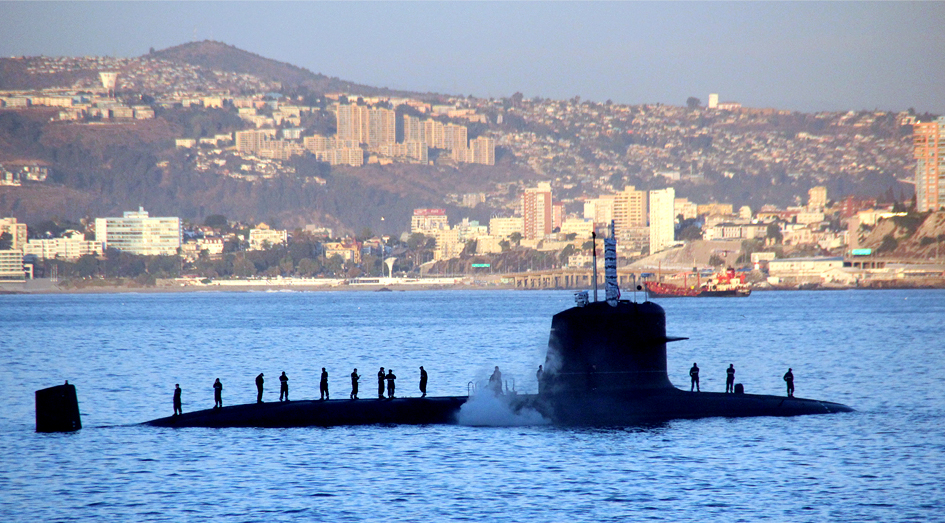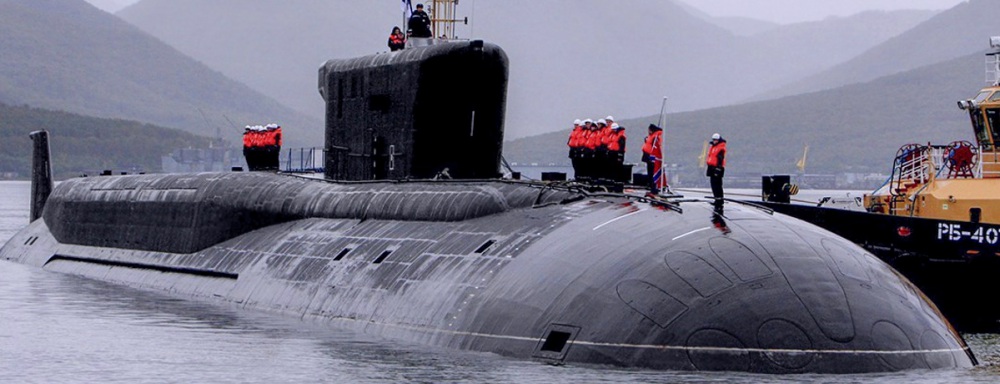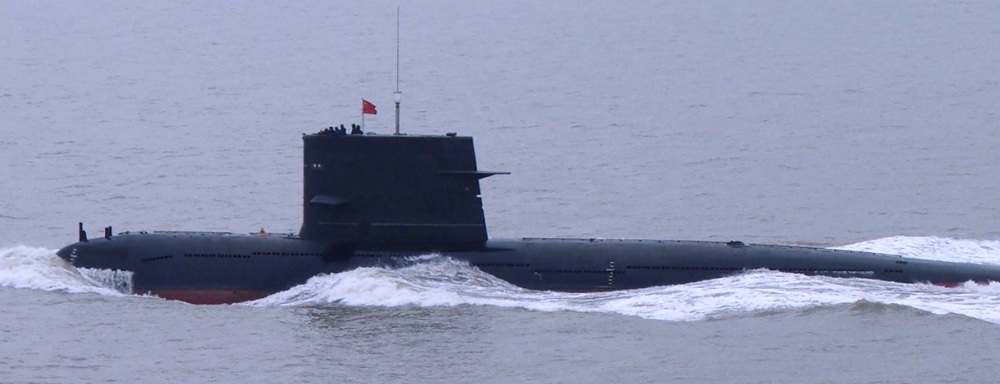
About the image
Capabilities at a Glance
The Chilean Navy currently operates a flotilla of four diesel-electric attack submarines. The fleet comprises of two Thomson-class (Type 209/1400) submarines and two Scorpène-class submarines, all of which are based in Talcahuano.1
Total Submarines in Fleet: 4
- Ballistic Missile Submarine (SSBNs): 0
- Nuclear-Powered attack submarines (SSNs): 0
- Diesel-electric attack submarines (SSKs): 4
- Air-independent propulsion (AIP) enabled: 2/4
Submarines
History
Chile’s two Thomson-class submarines, the CS Thomson (SS-20) and CS Simpson (SS-21), were constructed by German firm Howaldtswerke-Deutsche Werft (HDW) in Kiel. Chile’s two Scorpène-class submarines were jointly developed and constructed by the Spanish shipbuilder Navantia and French company Naval Group. The O’Higgins (SS-23) was built at the Naval Group shipyard in Cherbourg and commissioned in 2005. The Carrera (SS-22) was built at the Navantia shipyard in Cartagena and commissioned in 2006.2
Modernization and Current Capabilities
In 2009 Naval Group upgraded the Thomson (SS-20) to operate the Submarine Tactical Integrated Combat System (SUBTICS) Submarine Combat System and carry the Whitehead Alenia Sistemi Subaquei (WASS) Black Shark heavyweight torpedoes. In 2012, Naval Group upgraded the Simpson (SS-21) with these capabilities as well.3 Further modernization is underway to keep these submarines in service until 2030, at which point they are scheduled to be replaced after 46 years in service.4
Despite Chile’s rapid modernization and replacement rate, it is not expected that it will expand beyond its current fleet of four diesel-electric submarines.5
Chilean company Vapor Industrial announced in 2012 that they are planning to construct a Crocodile-class 250 submarine. The vessel, introduced as a “light SSK,” is intended to be used in a coastal-littoral denial role, outfitted with both wire-guided torpedoes and anti-ship missiles.6 While the construction of the Crocodile-class submarine was expected to take 12-18 months, there are no official updates on the status of the vessel.7
Ship Biographies
Thomson-Class (Type 209/1400-L)
Chile possesses two Thomson-class diesel-electric attack submarines. These submarines are 64.6 meters long with a 6.5-meter beam and can travel up to 22.5 knots when submerged. They can remain submerged for about 50 days without surfacing and are armed with eight 533mm torpedo tubes. Their weapons system can carry up to 14 torpedoes. The Thomson-class submarines can support a crew of 36 people.8
Scorpène-Class
Chile possesses two Scorpène-class diesel-electric attack submarines. These submarines are 61.7 meters long with a 6.2-meter beam and can travel up to 20 knots when submerged. They can remain submerged for about 50 days without surfacing. The Scorpènes are equipped with flank-area sonar and six 533mm torpedo tubes that can deploy WASS Black Shark heavyweight torpedoes and SM-39 Exocet anti-ship missiles with a range of 50km. Their weapons system can carry a total of 18 torpedoes and missiles or 30 mines. These submarines also possess an AIP system and employ the SUBTICS combat management system. The Scorpène-class submarines can support a crew of 32.9
Import and Export Behavior
Imports
The Chilean government imported two Type 209 submarines from Germany’s HDW in 1984, and two Scorpène-class submarines from France’s Naval Group in 2005 and 2006.10
Exports
Chile is not an exporter of submarines.
Explore the Collection
Australia Submarine Capabilities
Brazil Submarine Capabilities
Your are currently on
Chile Submarine Capabilities
China Submarine Capabilities
France Submarine Capabilities
Germany Submarine Capabilities
Greece Submarine Capabilities
India Submarine Capabilities
Indonesia Submarine Capabilities
Iran Submarine Capabilities
Israel Submarine Capabilities
Italy Submarine Capabilities
Japan Submarine Capabilities
Malaysia Submarine Capabilities
Netherlands Submarine Capabilities
North Korea Submarine Capabilities
Pakistan Submarine Capabilities
Russia Submarine Capabilities
Singapore Submarine Capabilities
South Korea Submarine Capabilities
Sweden Submarine Capabilities
Taiwan Submarine Capabilities
United States Submarine Capabilities
Submarine Detection and Monitoring: Open-Source Tools and Technologies
Stay Informed
Sign up for our newsletter to get the latest on nuclear and biological threats.
More on

Russia Submarine Capabilities
Overview of Russia's submarine capabilities and import-export behavior.
United States Submarine Capabilities
Overview of the United States' submarine capabilities and import-export behavior.

China Submarine Capabilities
A highlight of global trends in the sale and acquisition of diesel- and nuclear-powered submarines by country with capabilities, imports and exports. (CNS)
Glossary
- Diesel-electric submarine
- Diesel-electric submarine: A submarine with a diesel-electric transmission. Diesel-electric transmissions require access to oxygen for the diesel generator to charge the submarine’s batteries or drive the motor. This type of submarine is thus louder and must surface more frequently than a nuclear-powered submarine. A diesel-electric submarine can fire conventional cruise missiles against land targets, and in theory, can also carry nuclear-tipped cruise missiles. Diesel-electric submarines are significantly cheaper to build and purchase than nuclear-powered vessels, which makes them the vessel of choice for smaller navies.
- SSBN
- Ship, Submersible, Ballistic, Nuclear: A hull classification for a submarine capable of launching a ballistic missile. The "N", or nuclear, refers to the ship's propulsion system. SSBN's are generally reserved for strategic vessels, as most submarine launched ballistic missiles carry nuclear payloads. A non-strategic vessel carries the designation SSN, or attack submarine.
- Diesel-electric submarine
- Diesel-electric submarine: A submarine with a diesel-electric transmission. Diesel-electric transmissions require access to oxygen for the diesel generator to charge the submarine’s batteries or drive the motor. This type of submarine is thus louder and must surface more frequently than a nuclear-powered submarine. A diesel-electric submarine can fire conventional cruise missiles against land targets, and in theory, can also carry nuclear-tipped cruise missiles. Diesel-electric submarines are significantly cheaper to build and purchase than nuclear-powered vessels, which makes them the vessel of choice for smaller navies.
- Air Independent Propulsion Technology (AIP)
- Air Independent Propulsion Technology (AIP): A propulsion system that uses liquid (or compressed) oxygen or hydrogen fuel cells, thereby allowing submarines to stay submerged for longer periods without the need for external sources of oxygen. This increased endurance also increases a submarine’s survivability.
- Air Independent Propulsion Technology (AIP)
- Air Independent Propulsion Technology (AIP): A propulsion system that uses liquid (or compressed) oxygen or hydrogen fuel cells, thereby allowing submarines to stay submerged for longer periods without the need for external sources of oxygen. This increased endurance also increases a submarine’s survivability.
Sources
- “SS-20 Thomson,” GlobalSecurity.org, 11 December 2012.
- “SSK Scorpene-Class Attack Submarine,” Naval Technology, (2012), www.naval-technology.com.
- “El submarino chileno Simpson se reincorpora al servicio tras su modernización en ASMAR,” Información de Defensa y Securidad, 18 June 2012, www.infodefensa.com.
- Nicolás García, “Submarinos de la Armada de Chile, Proyección y Poder Naval en el Pacífico Sur [Submarines of the Chilean Navy, Force Projection and Naval Power in the South Pacific],” Infodefensa.com, July 2, 2021.
- “Jane’s Sentinel Security Assessment: Procurement - Chile,” IHS Jane’s, 25 March 2014, www.janes.com.
- “Military Submarines Type 209 Class,” Military Submarines, (2012), military-submarines.com.
- Cony Sturm, “Crocodile Class 250, el primer submarine de rescate construido en Chile,” FayerWayer, 12 April 2012, www.fayerwayer.com.
- “Military Submarines Type 209 Class,” Military Submarines, (2012), military-submarines.com.
- “SSK Scorpene-Class Attack Submarine,” Naval Technology, (2012), www.naval-technology.com; “Scorpene-Class Patrol Submarine,” Military-Today.com, (2006); “Scorpene Class Diesel Air Independent Propulsion Patrol Submarine,” Navy Recognition, 6 April 2012, www.navyrecognition.com.
- “Janes Underwater Warfare Systems: Submarine Forces – Chile,” IHS Jane’s, 15 June 2011, www.janes.com.
